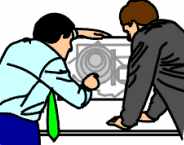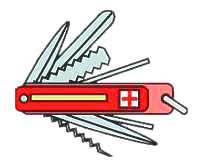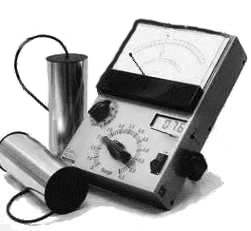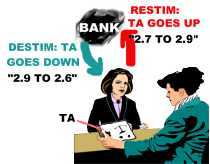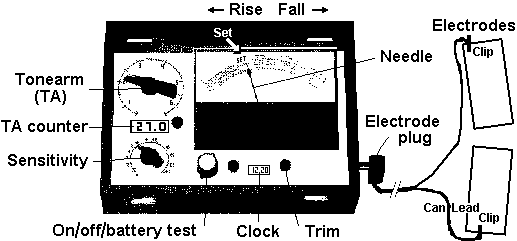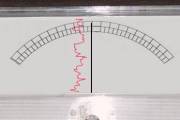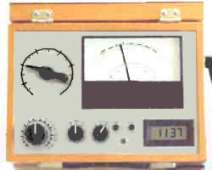How the Meter Works |
|||||||||||||
|
The Meter is in principle a simple measuring instrument. It basically measures electrical resistance. The building of a good Meter takes however great skill. The Meter's movements are caused by the change in electrical resistance of mental masses around the pc. Here is how it works: a battery inside the Meter sends a low electrical current through the cans the pc will hold in his hands (see picture). The current runs from the one can, through pc's body and is picked up again by the other can. The battery is 9 Volts, but only about 2 Volts actually go through the pc. As the current "runs around through the pc's body" it runs into a certain resistance caused by the body. It also runs into the mental masses produced by the pc. The pc produces these in order not to look at the terrible things in his Bank. These masses add to the body resistance and make the needle rise on the dial (go to the left). In order to keep the needle on the 'Set'-position on the dial, the auditor will move it to the right. To do so, he turns the big knob on the Meter higher (clockwise). He "opens the throttle" and allows more current to flow out to overcome the extra resistance. The big knob is called the Tone Arm (TA). It has a scale with numbers on it. In other words, when the PC runs into a mental mass, the needle "rises".
When the pc has duplicated some part of the mass in his Bank and looked at it as it is, his tension immediately relaxes. Therefore the electrical resistance of his "mental defense shield" lessens; the needle falls (goes to the right) and the auditor adjusts the Tone Arm to put the needle back on Set. This blowing of charge is called a TA Blowdown or BD. The amount of charge "blown" can be seen on the Tone Arm (TA). Let's say the TA pointed at 2.5 at sessions start. When the pc's resistance against looking at the mass was the highest the TA went up to 4.6. Then, after the pc managed to look at and duplicate that particular part of the mass (and the content in it), the TA moved down to 3.1. So the total charge blown at this point is the difference between 4.6 and 3.1, which is 1.5 division.
This can happen several or many times with the same mass. At the end of the session, when the pc has seen the content and the details in the mass, and it has nothing left he couldn't easily look at, the TA will not move anymore. The process has gone flat. Now the auditor can add up all the downward motions (divisions) of the Tone Arm. (Or read the Tone Arm Counter). He can divide the total by the number of session hours it took and thus get a figure per hour. Five divisions of TA motion per hour - the TA-Action - would be quite effective and acceptable. The more the better. (See Meter Drill 6.) This figure of "TA-Action per hour" is a valuable indicator of the progress the pc is making. When there is no more TA action on a process it has to be changed. Another process is found to again produce TA Action. Being good at reading the Meter takes a lot of skill and experience. Therefore a lot of time in auditor training is spent on the "Meter Drills". To the beginner the needle seems but a madly wiggling thing. To the expert each needle motion allows exact conclusions about what is going on with the pc's attention. The Meter does not tell the auditor what picture the pc sees. But it tells him when the pc is in a 'hot area'. When he is backing off from it, when he is right in it blowing it to pieces, and also when there is no charge left on an item or mass and the auditing action is complete. The Meter allows the auditor to steer the pc's attention exactly, and helps him do effective work in session. Auditing takes place between two beings or thetans: the auditor and the pc. It does not take place between the auditor and the Meter. The Meter is only a help. The auditor observes the pc's indicators, such as his changing position on the tone scale, his hesitation in answering a question (comm lag), his blushing or smiling or crying, his change from brightness to dullness and back. All these things show directly that the process produces changes and results. The auditor observes the needle reactions on the Meter. This gives him a technical reading, that something is happening. It gives him visible evidence of some Reactive Charge, that may be so fine, that the auditor wouldn't be able to see it from the pc's face. When you see a reaction on the Meter the auditor will want to follow up on it. If he sees a Fall on the Meter he knows there is charge on the process. The Meter does not and can not replace the live ARC between auditor and pc, but it can give the auditor valuable information, which helps him determine, what to take up and what not. The Meter is a steering device. That's its whole purpose.
What is a
Read? Not knowing something one desires to know creates tension. It is the same phenomenon as reading a thriller or wondering what one is going to get for Christmas. Finding out and knowing brings relief. Anytime the pc (or any person) experiences relief there will be a big read. For a little bit of relief only, there will be a small read. It all depends on the importance the pc puts on the item in the first place and on the amount of reactive content he can confront at the time.
These are the most common reads: Long Fall Blowdown (LFBD or BD): When the needle does a Long Fall and stays on the right hand side of the dial, the auditor must move the TA downward in order to bring the needle back up to 'Set'. This way the TA "blows down". Tick (T): A Tick is smaller than a SF. Usually it is not taken up, as it is a sign of there not being enough charge to deal with the item successfully. It does not count as a read, strictly speaking, but just as a hint of a possible read. One can look around a little in such an area, but when there is not more than another Tick or two, one should not do anything with it.
Dirty Needle (DN): It looks like many small ticks going left and right in an irregular fashion. It shows that something goes on in pc's mind which has not been expressed yet. (References: "The Book of E-Meter Drills", "E-Meter Essentials", "Introduction to the E-Meter", by R. Hubbard.) "YES" and
"NO" The pc says something; it reads: "Yes". It doesn't read: "No". The read confirms the auditor's question or the pc's origination as true. Why? - Because an As-isness occurs, however small it may be. "Truth is the exact consideration; the exact time, place, form, and event. Thus we see that the discovery of truth would bring about an As-isness by actual experiment" (From Axiom 38. The "actual experiment" is the session itself.) Any partial As-isness reduces some of the charge, so you have less electrical resistance, so you get a read. Examples: "Do you have a problem?", no read = He doesn't have a problem. "Do you have a problem?", no read. Pc says, "No, I don't think so", plus read = He doesn't have one. (Meter confirms pc's answer.) Pc says at session start, "I feel great today", plus read: He had a release, but there is some charge connected with it. Find out about the release and acknowledge it. If it F/N's, great, leave it at that. If not, the read means there is some available Bank content connected with it. That should be found and dealt with while it is restimulated. That will make the win brighter. Hence one should "rehab" the release point. (See the section on "Rehabilitation" later in manual.) Pc says at session start, "Last night I had a terrible dream", with no read. So there is no charge. Acknowledge politely, but do not take it up (TR-4). Go into the process you have your instructions for.
The Instant Read It happens instantly as it hits the pc's Reactive Mind. The Reactive Mind, being a stimulus-response mind will react instantly and every time it is 'hit' and that is what you see on the Meter. It is important for it to happen exactly as described, that the pc is 'in-session' (interested in own case and willing to talk to auditor). It is also important, that he actually understands all the words said by the auditor. A lot of skill goes into accomplish this as part of drilling instant reads drill in the Meter drills (EM Drill 24). Instant reads are depended upon in Assessment of prepared lists. Here you do an Assessment by reading quickly to pc the questions on a prepared list. You take the read that occurs the moment you have finished saying each line. (See EM Drill 24.) This works well when you have prepared the pc for it. He has to have excellent duplication and understanding on what is going on and what is being said. The pc must have a conceptual understanding of what the auditor says and be 'in-session'. Instant reads on auditor's statements are not the only thing you take up. A valid read (that reads on the Reactive Bank) often happens as under the definition of 'Reading Item'. Reading Item, the
read is taken when the pc first says it or when the question is cleared.
This is the valid time of read. This definition defines what is a
reading item or question. Calling it back to see if it reads is not a
valid test as the surface charge may be gone but the item or question
will still run as it is charged.
The Floating Needle (F/N) Here is the definition: How does an F/N come about? At the moment you give the auditing command the pc connects up with a ridge (mass) in his Bank and a small As-isness occurs; you get a read. From this moment on the attention of the pc is on the ridge/mass/ incident/picture until he has As-ised (blown) it fully. It can be a key-out. Or the mass can have been completely As-ised and be gone. At this moment it goes "poof" and the compulsive comm-line to the mass/item breaks. The pc has no more attention on the thing. And that is the moment the needle floats! Its importance is that it indicates when to stop a process (as part of the End Phenomena). It helps you determine when that particular auditing cycle is complete. When it's a big release it will keep on floating for awhile. When the pc is in the middle of a series of processes, though, which all deal with the same area of charge ("communication" for instance), then his F/N will not necessarily last that long. It will stop as soon as the next ridge/mass has attracted the pc's attention. Here it is in detail: He has had attention on one particular bit of Bank in this area; he has blown that = F/N. Now he is drawn back into the area by the next bit of Bank. The F/N stops. You give the next command, get a read, work it over, F/N; next command, read, work it over, F/N, etc., till the whole area is discharged and the pc has a big release and a large F/N and VVGIs (Very Very Good Indicators). F/Ns are usually "indicated" to the pc, which means one tells him that he just has one. This is a way of acknowledging (TR-2) that an auditing cycle has been completed, that a release was attained. Make sure you don't make the pc 'dependent' on this F/N indication! Make sure he has experienced his F/N and feels it before you say: "I'd like to indicate, your needle is floating". (You say it as agreeing with the pc). This way he learns to find certainty in himself and not in the Meter. So indicate the F/N's, but make sure you have the VGI's in the pc that is part of the EP.
The False Read Therefore a false read is the pc's protest against what you are asking him. And that's why you handle a false read with the question: "Did anyone say you had a problem when you didn't have one? (read)". - Pc: "Yes (read), my mother always told me I was looking so confused when I wasn't confused at all! (read)". So the pc felt evaluated for or invalidated, and he was protesting it then just as he is protesting it now What you are really running here is a Chain of protests about inval/eval. Get all of the incident (with mother), when/where/what happened exactly; and then: "Is there an earlier similar time someone said you had a problem when you didn't have one?" At the end of the Chain you'll get a key-out and F/N plus VGIs. Completing Cycles of Action As one asks an auditing question, one has to make sure that the read occurs not only on the question, but on the answer as well! Failing to do this may result in your running an unreading item -the one mentioned by the pc - although there was a read on the actual question. Example: "Have you committed an overt?" (Fall). Pc: "Recently, when I took a walk in the park, I threw an empty cigarette pack on the lawn instead of putting it in the nearest rubbish bin" (X, which means no read). The auditor should not take this up as the 'overt' didn't read. If he had the pc tell all about it and then went earlier-similar on it, he would totally audit past the thing which actually caused the read. He would have taken up an unreading item - the one offered by the pc. And soon the usual trouble would follow: needle tightening up, TA rising, pc becoming disinterested, Chain not coming to an end. Incomplete cycle of action. Very embarrassing! The correct action in this case would have been to ask the pc: "Is there perhaps another overt?" (Again the F). "Well," says the pc, "When I drove my father's car the other day, I bumped against the garage door and didn't tell my father it was me who made the dent" (SF). That is the answer the auditor should take up. The read on the answer was smaller than the read on the question, yes, but that does not matter That is merely a matter of the pc's confront of his overt. The important thing is that there was a read. The lesson to be learned here: the read on the auditor's question must be echoed by the read on the pc's answer. When this happens one can be certain that the cycle of action of this particular auditing process can be taken to its proper end.
Based on L. Kin's 'The language of
the E-meter"
|
|||||||||||||




